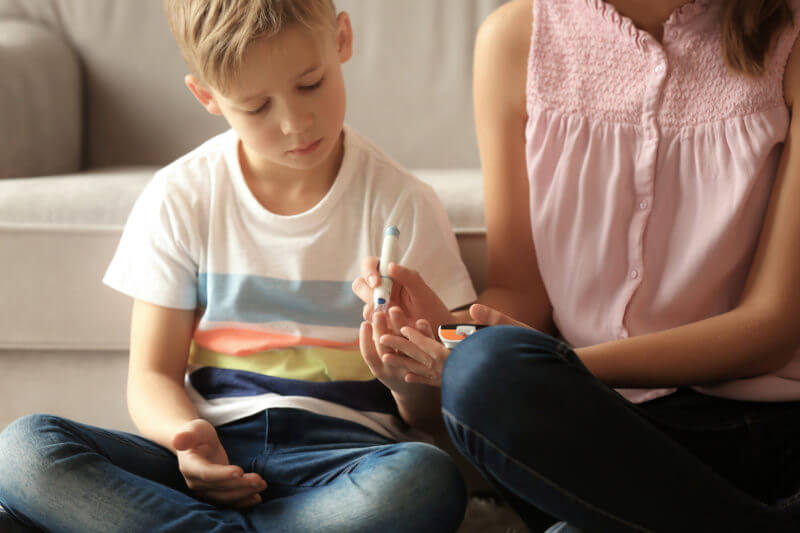by IHSG
Share
by IHSG
Share

Physicians treating pediatric diabetes are a bit like veterinarians: unable to count on their young patients to describe symptoms and feelings, they must rely on third parties (i.e. parents, caregivers, pet owners) to fill in the clinical picture. Parents, for their part, face the daily challenge of subduing their children’s restless energy and willfulness in the service of diabetes management.
Not just small adults
Children with diabetes differ in several obvious ways from their adult counterparts. For one thing, their organs are still “under construction”—including that all-important pancreas—and their body systems haven’t matured yet. Accordingly, children may differ from adults in their response to dropping blood glucose—for example, developing a counterregulatory response and subjective symptoms at a higher glucose level than adults.
Children’s behaviour can also complicate diabetes treatment: think of the toddler who refuses to eat after an insulin dose or the preschooler who won’t sit still for a shot. To add a further layer of complication, odd behaviours in children don’t necessarily mean the same thing they do in adults. An adult speaking incoherently raises immediate red flags for hypoglycaemia. A babbling or sputtering child, meanwhile, could be showing signs of low blood glucose—or simply be playing make-believe.
As parents know all too well, adolescence brings its own set of diabetes management challenges. Embarrassed at the mere thought of a hypoglycaemic episode, a teenager may prioritize hypo avoidance over meeting glucose targets. Some teenagers may loosen their vigilance in general, putting themselves at risk of harmful glucose swings in either direction. In fact, the DCCT trial revealed severe hypoglycaemia to be more prevalent in young people than in adults. At the same time, clinicians and parents can find reassurance in knowing that, despite the higher rates, long-term cognitive function did not decline in the youngest cohort of DCCT patients.1
Child-friendly approach
While plenty of adults thrive on diabetes gadgets and gizmos, it’s in children that the technology really comes into its own. By automating key functions of diabetes management, high-tech aids such as insulin pumps and continuous glucose monitoring (CGM) systems sidestep many of children’s unpredictable and confusing behaviours. Several pediatric studies have also found technology to yield modest gains in glucose control. In an analysis of over 16,000 children participating in the type-1 diabetes SWEET registry, for example, pump-treated children had lower HbA1C and required less insulin than children on multiple daily injections.2
As the technology keeps improving, so too do the options for high-tech interventions. In a study conducted earlier this year, children with type 1 diabetes used a remote monitoring system that let them share weekly information about blood glucose, insulin delivery and physical activity with their medical teams. Compared to the control group of conventionally managed children, the remotely monitored group experienced better glucose control and quality of life over the course of the 6-month study.3
Parents may need treatment, too—for anxiety. While it’s natural for the parent of a child with diabetes to worry about hypoglycaemia, the worry often becomes all-consuming, thus weakening the parent’s effectiveness as a guide and steadying force. As several studies have found, this fear of hypoglycaemia (FOH) can compromise diabetes control itself. In one such study, published in the journal Diabetic Medicine, parents with significant FOH-related distress had children with higher blood glucose levels. Perhaps surprisingly, these children also had a higher frequency of problematic hypoglycaemic episodes in the past year.4
For clinicians, monitoring the frequency and severity of hypoglycaemia in patients with diabetes is simply part of good care. It also falls to physicians to explore whether parents are fearful of hypoglycaemia as not all parents will readily admit it. If FOH is an issue, clinicians and diabetes educators need to arm parents with strategies to bring the anxiety down to manageable levels. Proven approaches include systematic hypoglycaemia education and cognitive behavioural therapy to address the FOH head-on.5 At the same time, parents need to be warned that an episode of severe hypoglycaemia puts the child at increased risk of a further episode.
Parents also play a crucial role in helping their older children transition to self-management. If the parent has always taken responsibility, some children may reach adolescence without understanding hypoglycaemia. Parents should be encouraged to provide age-appropriate explanations to their children and help them transition to self-monitoring and self-care.
It goes without saying that anyone involved in caring for the affected child—from parents and babysitters to teachers and daycare workers—should have an action plan to deal with hypoglycaemic episodes. When people have the right information, they feel more in control—and stress levels go down all around.
References
- Musen G et al. Impact of diabetes and its treatment on cognitive function among adolescents who participated in the Diabetes Control and Complications Trial. Diabetes Care 2008; 31:1933.
- Szypowska A. Insulin pump therapy in children with type 1 diabetes: analysis of data from the SWEET registry. Pediatr Diabetes 2016; Suppl 23:38.
- Gandrud L et al. Intensive remote monitoring versus conventional care in type 1 diabetes: A randomized controlled trial. Pediatric Diabetes 2018; 19:1086.
- Haugstvedt A et al. Fear of hypoglycaemia in mothers and fathers of children with Type 1 diabetes is associated with poor glycaemic control and parental emotional distress: a population-based study. Diabet Med 2010; 27:72.
- Driscoll KA. Fear of Hypoglycemia in Children and Adolescents and Their Parents with Type 1 Diabetes. Curr Diab Rep 2016; 16:77.






